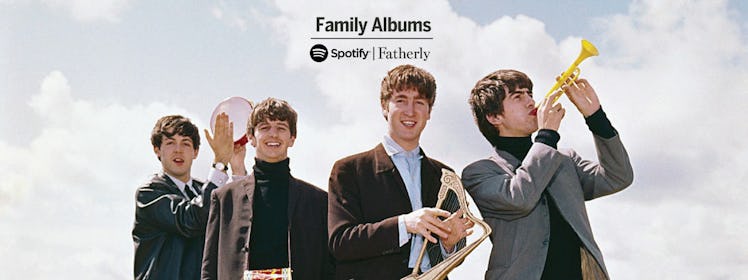How To Introduce The Beatles To Your Kids, With 2 Beatleologists
Whisper words of wisdom, let it stream.

The following was produced in partnership with our friends at Spotify.
Already bigger than Jesus, the Beatles recently proved they’re also bigger than Santa by delivering the whole world the best Christmas gift ever: their entire glorious catalog, finally available for streaming. The most joyful recipient of that present should have been you, the father who until now was forced to try and foist your love Liverpool’s favorite sons via clunky, outdated formats, like 8-tracks and MP3s. Now, it’s only a few clicks to go from a kiddie cover version (looking at you, Caspar Babypants) to the genuine article and facilitate a whole new kind of musical discovery for your Junior John — or Paul, depending on whether your kid is the smart one or the cute one.
To ensure you have the most fab kid in daycare, follow the advice of a pair of Beatles scholars. NYU music professor Thomas MacFarlane and Beatles lecturer Scott Freiman don’t just have the best jobs ever; they have kids of their own that they had to indoctrinate in those dark ages, PBS (that’s Pre Beatles Streaming). But even if the medium has changed, the message remains the same: All you need is love … and an encyclopedic knowledge of kid-friendly Beatles’ tunes, plus some cool anecdotes.
Start With The Sound
Kids hear a sound and they instantly like it or they don’t. They don’t know jack about chord progressions or the relationship between bass and melody or why you can’t hear the symphonic genius they’re clanging out on that toy piano. “Based on my experience, what young people really respond to is sound,” says MacFarlane. “I can remember the quality of the harmonica part on ‘ There’s A Place.’ I just loved that harmonica. I was fascinated by it.”
Start your kid’s Beatles lessons with a simple, clean slate and let their tastes evolve as their understanding and exploration of sound does. That strategy worked out pretty well for the actual Beatles.
Remember That Every Song Tells A Story
The Beatles created a cast of characters matched only by the Simpsons and possibly the Muppets. “Every song on Sgt. Pepper’s is about a character,” says Freiman. “‘Mr. Kite,’ ‘Lucy In The Sky‘, ‘Lovely Rita.’ Lots of personalities in those songs, which makes them great for kids.” Adds MacFarlane, “They’re all points of reference; people you can connect with inside the song that make it more enjoyable and relevant to your experience.”
Your kid is practically guaranteed to find something relatable, either in a character who could be a distant cousin to their favorite bedtime story hero, or the many references to the Mop Tops’ childhoods and children. “Rocky Raccoon” tells a tale. “Penny Lane” and “Strawberry Fields Forever” are idyllic references to John Lennon’s childhood home (places he remembers, as it were). “Yellow Submarine” was Paul straight up seeing if he could write a kids’ song just because nobody else in rock and roll would have thought to and he was a cheeky bastard like that. “Martha My Dear” is about Paul’s old sheepdog, and their biggest song ever, “Hey Jude,” was originally written to a child — McCartney hoped it would comfort Lennon’s son, Julian, through his parents’ divorce.
Besides storytelling songs, the Beatles, always ahead of their time, also made movies — perfect for brainwashing already screen-obsessed kids. Most of the fathers Freiman has asked say they introduced their kids to the Beatles through the Yellow Submarine movie. And even if they have no clue what the hell is going on, he says, at the very least kids will giggle through A Hard Day’s Night watching 4 funny looking English dudes flee from screaming teenage girls.
Embrace The Singalong (All Together Now!)
Right about the time the Beatles were coming up, there was an explosion of kids — a “boom,” one might say — and the band recognized it. McCartney, in particular, has a flair for the singalong.
“Yellow Submarine” was Paul straight up seeing if he could write a kids’ song just because nobody else in rock and roll would have thought to.
“There’s something very easy to grasp about the music,” Freiman says. “The complexity is hidden within wonderful melodies, easy to sing choruses, easy to understand lyrics; they write songs that kids can really appreciate because they’re fun.”
With that in mind, start at the very beginning. Early tunes like “I Want To Hold Your Hand,” “She Loves You,” and “Please Please Me” are “great little pieces kids can dance and tap along to,” Freiman says. Other singalongs he recommends: the nonsensical “Ob-La-Di, Ob-La-Da,” the Ringo-voiced “Octopus’ Garden,” and the always lovely “Here Comes The Sun.”
And if all your kid really wants to do is bang their head: “Back In The USSR” on repeat.
Facilitate Organic Discovery By Helping To Make Connections
As you’re probably aware, kids are programmed to immediately reject anything you present to them as cool. The more effective, if also more methodical, approach is to forge a connection between what they already like (“The Wheels On The Bus”) and what you know they need to like (“Drive My Car“).
“Listen to what they’re listening to, see what they’re responding to, and spot connections to things you’re familiar with in the Beatles’ catalog, whether it’s pure sound or lyrical content or ideas,” says MacFarlane. For example, his now 24-year-old son responded to the theatricality and intensity of ” Eleanor Rigby” as a 5-year-old classical music buff. “When your kids appreciate the entire process the Beatles are a part of, you stand a better chance of getting them to really listen.”
Of course, that’s easy for him to say — his kid was into classical music at 5 years old.
This article was originally published on